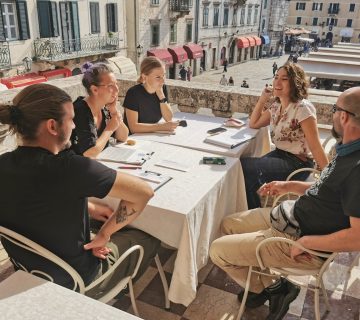In 2013-2015, the Slovene Ethnographic Museum (SEM) implemented the project ‘Accessibility of Cultural Heritage to Vulnerable Groups’, which was partly financed by the European Union through the European Social Fund and the Ministry of Culture.
The main objective of the project was training of nine members of vulnerable groups who will be able to work in the museum. In addition to training at SEM, the trainees have been trained at the Museum of Contemporary History of Slovenia, the Slovenian National Museum, the National Gallery, the Natural History Museum of Slovenia, the Slovenian Theatre Institute and the Technical Museum of Slovenia. The project will increase the availability of technical museum premises. SEM was augmented by installing induction loops, which can help impaired people to follow the direction of the exhibitions with tactile maps for orientation of blind and partially-sighted people in the museum. They have produced replicas of some museum objects that are placed in the permanent exhibition ‘Between Nature and Culture’, and the visitors enjoy approaching and touching them. Replicas are of different sizes, structures and materials (wood, metal or a combination of materials), representing the characteristics of particular historical periods, manufacturing techniques and ways of life; they make the visitors aware of the material and non-material heritage of Slovenes and some non-European cultures. In the exhibition, which we have called ‘A Touch of the Past’, visitors can use the audio guides in several languages, access a tablet in Slovenian sign language for the hearing-impaired and the accompanying publication. At the same time, the museum upgraded its website in accordance to web-content accessibility guidelines.
Several training courses were prepared within the project:
- physical and communication accessibility
- inclusive museum and program preparation
- integration of vulnerable social groups and employment possibilities
- preparation and management of culture and cultural heritage projects
- preparation of audio description.
Training courses were aimed at museum staff, other professionals and the general public; their objective was to improve qualifications, knowledge, skills and competence for working with vulnerable groups.
The project employees and their mentors – consultants – developed and implemented educational programs in order to increase the accessibility of heritage to all visitors in a way that includes the representatives of the identified target groups as active participants. One of the project objectives was to include relevant students, especially those belonging to vulnerable groups.
The following activities were carried out:
- guided tours with tactile elements based on a multi-sensory experience
- musical guided tours
- guided tours/programs for the deaf and hard of hearing
- collaboration with Roma communities
- programs with immigrants and minority members
- travelling programs (for those that cannot visit museum because of their impairment
Exhibitions including:
- Photographic Images from the Life of the Deaf and Hard of Hearing in Ljubljana
- Nino: Human Optimism; Look at Me and You’ll See
- Birth: Experiences of Roma Women
- Images of Emona 2015
In addition, students, belonging to vulnerable groups participated in individual exhibition projects.
This project is one of the examples of good practice of integrating vulnerable social groups into the field of cultural heritage. Two years of work by staff is presented in the study Accessibility of Cultural Heritage to Vulnerable Groups: Study on the Availability and Provision of Technical Conditions to Provide Vulnerable Groups with Access to Cultural Heritage, which is available in Slovene and English.
To cite this article:
Roanc, E. (2015) ‘Accessibility of cultural heritage to vulnerable groups’. In Interpret Europe Newsletter 4-2015, 12-13.
Available online:
https://www.interpret-europe.net/fileadmin/Documents/publications/Newsletters/ie-newsletter_2015-4_winter.pdf




